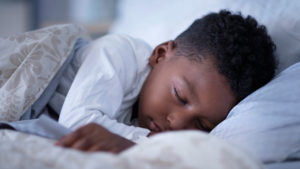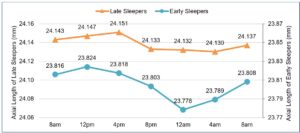February 1, 2023
By Xiao (Nicole) Liu, PhD candidate at UNSW School of Optometry and Vision Science and BHVI
Studies have associated more myopia with problematic sleep, including poor quality, insufficient hours, late bedtime, and delayed melatonin circadian timing.
 The world has witnessed an ongoing increase in myopia prevalence over the last few decades, regardless of geographic location. Compromised vision resulting from myopia can lead to a significant economic burden on both the individual and the society.1 The need to prevent myopia and control those who are already myopic is becoming imperative. Due to its complex multifactorial nature, the cause or etiology of myopia remains an unsolved puzzle for eye care professionals, and many risk factors have been found to be associated with it.2
The world has witnessed an ongoing increase in myopia prevalence over the last few decades, regardless of geographic location. Compromised vision resulting from myopia can lead to a significant economic burden on both the individual and the society.1 The need to prevent myopia and control those who are already myopic is becoming imperative. Due to its complex multifactorial nature, the cause or etiology of myopia remains an unsolved puzzle for eye care professionals, and many risk factors have been found to be associated with it.2
Of the identified risk factors, two major behavioral risk factors for childhood myopia incidence and progression, namely education and insufficient outdoor time, have been confirmed across many studies. Lately, emerging evidence from several studies has been accumulating for the role of sleep in childhood myopia. Here’s what we know so far.
How Does Sleep Affect Eye Health?
Sleep is fundamental for children’s health, and poor sleep has been associated with health problems.3 Unfortunately, sleep or circadian disruptions, such as irregular sleep timing (bedtime or wakeup time) and short duration, are frequently observed in children and young adults.4-7
Importantly, several studies have associated more myopia with problematic sleep, including poor quality, insufficient hours, late bedtime, and delayed melatonin circadian timing.5,8-10 Additionally, a higher concentration of melatonin, the hormone that initiates sleep, was identified among myopic individuals in the morning compared to non-myopes.11,12 Does this mean that myopes have more overnight melatonin residue, which can increase their daytime sleepiness? Is this difference associated with daily outdoor hours? Future studies may be able to answer this question.
The Role of Genetics and Circadian Rhythm
The importance of a regular light-dark cycle or circadian rhythm on the normal development of the eye was noticed early in the 1950s and has been endorsed by many later studies.13-17 Genetic factors involved in circadian entrainment were associated with refractive error development;18 modifications to the Clock Gene that regulates circadian rhythm could stimulate abnormal ocular growth and induce myopia.19 Meanwhile, diurnal rhythms were detected in various ocular components. For instance, axial length of the eye is the longest around midday and decreases to the shortest around midnight before elongation starts.17,20 Amongst those rhythms, variations in axial length and choroidal thickness are of particular interest to myopia research.21 A recent study found significant differences in refractive error and axial length diurnal changing patterns between late versus early sleepers, suggesting a connection between poor sleep and myopia through disrupted ocular rhythms (Figure 1).22 Nevertheless, more studies are required to understand the full picture.
Additionally, although outdoor time is a well-established protective factor against childhood myopia, the mechanisms underlying its protective effect are not well understood and are still being carefully examined. Some of the various hypotheses include dopamine release, vitamin D levels, and different spatial frequency compositions.2 In fact, taking sleep into consideration may offer a new perspective. Outdoor activities can produce better sleep as it promotes the regulation of melatonin secretion, leading to regular sleep onset in children.23 Seasonal variations, probably due to differences in day lengths or light hours between seasons, were observed in myopia development, axial length diurnal rhythms, and sleep patterns,24-26 indicating a complex relationship among these factors.
In summary, although underlying mechanisms are yet to be elucidated, the role of poor sleep and disturbance to the circadian rhythm in childhood myopia is supported by mounting evidence. Including guidelines encouraging good sleep hygiene, such as regular timing for sleep and sufficient hours, in ocular health promotion campaigns targeting children should be of high priority.
 |
Xiao (Nicole) Liu is a current PhD candidate at UNSW School of Optometry and Vision Science and the Brien Holden Vision Institute, under the supervision of Professor Padmaja Sankaridurg and Associate Professor Thomas John Naduvilath. Dr. Liu received her Bachelor of Clinical Medicine (Optometry and Ophthalmology) from Tianjin Medical University in China before obtaining her Master of Optometry degree in 2012 at UNSW. After working as a clinical research optometrist for a few years, she decided to pursue a PhD degree in optometry. She has been awarded the inaugural Dr. David Wilson Memorial Scholarship for her PhD. She was also awarded the ARVO Travel Grant and the ISCLR Student Abstract Grant in 2022 for her research on myopia and circadian rhythm. |
Reference
- Sankaridurg, P., et al., IMI Impact of Myopia. Invest Ophthalmol Vis Sci, 2021. 62(5): p. 2.
- Morgan, I.G., et al., IMI Risk Factors for Myopia. Invest Ophthalmol Vis Sci, 2021. 62(5): p. 3.
- Matricciani, L., et al., Children’s sleep and health: A meta-review. Sleep Med Rev, 2019. 46: p. 136-150.
- Liu, X., et al., Sleep patterns and sleep problems among schoolchildren in the United States and China. Pediatrics, 2005. 115(1 Suppl): p. 241-9.
- Jee, D., I.G. Morgan, and E.C. Kim, Inverse relationship between sleep duration and myopia. Acta Ophthalmologica, 2016. 94(3): p. e204-e210.
- Ostrin, L.A., et al., Sleep in myopic and non-myopic children. Translational Vision Science and Technology, 2020. 9(9): p. 1-13.
- Eisenbarth, W., et al., Prevalence of Amblyogenic Risk Factors among Preschool Children in Rural Ghana. Investigative Ophthalmology and Visual Science, 2022. 63(7): p. 4463-A0173.
- Ayaki, M., et al., Decreased sleep quality in high myopia children. Scientific Reports, 2016. 6: p. 33902.
- Liu, X.N., et al., Sleeping late is a risk factor for myopia development amongst school-aged children in China. Scientific reports, 2020. 10(1): p. 17194.
- Chakraborty, R., et al., Myopia, or near-sightedness, is associated with delayed melatonin circadian timing and lower melatonin output in young adult humans. Sleep, 2021. 44(3).
- Kearney, S., et al., Myopes have significantly higher serum melatonin concentrations than non-myopes. Ophthalmic Physiol Opt, 2017. 37(5): p. 557-567.
- Flanagan, S.C., et al., Elevated Melatonin Levels Found in Young Myopic Adults Are Not Attributable to a Shift in Circadian Phase. Invest Ophthalmol Vis Sci, 2020. 61(8): p. 45.
- Jensen, L.S. and W.E. Matson, Enlargement of Avian Eye by Subjecting Chicks to Continuous Incandescent Illumination. Science, 1957. 125(3251): p. 741-741.
- Lauber, J.K. and J. Shutze Jv Mcginnis, Effects of exposure to continuous light on the eye of the growing chick. Proc Soc Exp Biol Med, 1961. 106: p. 871-2.
- Stone, R.A., et al., Photoperiod, early post-natal eye growth, and visual deprivation. Vision Res, 1995. 35(9): p. 1195-202.
- Nickla, D.L., Ocular diurnal rhythms and eye growth regulation: Where we are 50 years after Lauber. Experimental eye research, 2013. 114: p. 25-34.
- Chakraborty, R., et al., Circadian rhythms, refractive development, and myopia. Ophthalmic and Physiological Optics, 2018. 38(3): p. 217-245.
- Hysi, P.G., et al., Meta-analysis of 542,934 subjects of European ancestry identifies new genes and mechanisms predisposing to refractive error and myopia. Nat Genet, 2020. 52(4): p. 401-407.
- Stone, R.A., et al., Altered ocular parameters from circadian clock gene disruptions. PloS one, 2019. 14(6): p. e0217111-e0217111.
- Ostrin, L.A., et al., Twenty-four hour ocular and systemic diurnal rhythms in children. Ophthalmic Physiol Opt, 2019. 39(5): p. 358-369.
- Nickla, D.L., The phase relationships between the diurnal rhythms in axial length and choroidal thickness and the association with ocular growth rate in chicks. Journal of Comparative Physiology A, 2006. 192(4): p. 399-407.
- Liu, X.N., T.J. Naduvilath, and P. Sankaridurg, Later bedtime associated with greater myopic refractive error and variations in axial length rhythms. Investigative Ophthalmology & Visual Science, 2022. 63(7): p. 4328 – A0033-4328 – A0033.
- Janssen, X., et al., Associations of screen time, sedentary time and physical activity with sleep in under 5s: A systematic review and meta-analysis. Sleep Med Rev, 2020. 49: p. 101226.
- Donovan, L., et al., Myopia progression in Chinese children is slower in summer than in winter. Optometry and vision science: official publication of the American Academy of Optometry, 2012. 89(8): p. 1196-1202.
- Nilsen, N.G., et al., Seasonal Variation in Diurnal Rhythms of the Human Eye: Implications for Continuing Ocular Growth in Adolescents and Young Adults. Invest Ophthalmol Vis Sci, 2022. 63(11): p. 20.
- Mattingly, S.M., et al., The effects of seasons and weather on sleep patterns measured through longitudinal multimodal sensing. NPJ Digit Med, 2021. 4(1): p. 76.














